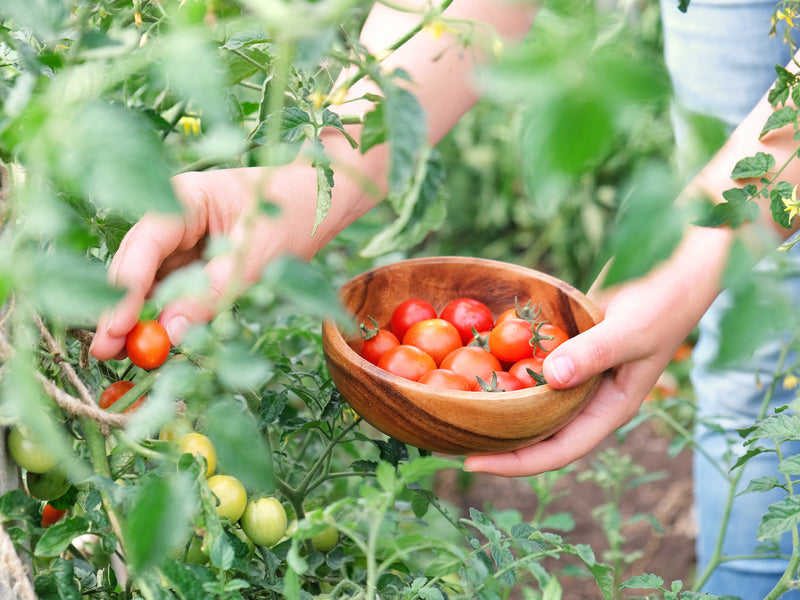Green beans are an easy and fun vegetable to grow. Below is our guide from seed starting to harvesting!
POLE BEANS VS. BUSH BEANS
There are two varieties of beans, pole and bush. Bush beans grow in a bush-like form as the name suggests. Pole beans grow tall and need added support or poles to climb up. Bush beans grow about 2 feet tall and are suitable for small garden spaces. Pole beans grow very tall so its important that they are well supported with trellises and poles. The also do well growing up fences. Choose the type of bean that works best for your garden space!
PLANTING
Start indoors using 4 inch pots. Plant only 2 seeds per pot in moist seed starting soil 1/2’- 1” below the surface and cover with a layer of soil (do not pack). Or, start your seeds directly in your garden space if temperatures are 50° or warmer. If starting your seeds in your outdoor garden location, skip down to the section PLANTING LOCATION.
SOIL
Use seed starting organic potting mix or Spade To Fork organic soil disks. Soil should be loose and moist, never hard packed.
WATER
2-3 oz per watering, or less per 4 inch pot. Allow the top 1/2’ of soil to dry slightly between waterings. DO NOT over-water or white fuzz (fungus) will grow on pots and soil.
AIR
Well-ventilated room, use a small fan to increase airflow
SUNLIGHT
6-8 hours per day of direct sunlight, or 12-16 hours per day grow lights
TEMPERATURE
50° and 85° (65-75 degrees ideal for sprouting)
GERMINATION
8-10 days to see sprouts

THINING
Remove weaker seedling when the strongest seedling is about 2 inches. Remove by cutting off at soil level with scissors being careful not to disturb the roots of the remaining seedling.
TRANSITIONING TO OUTDOORS
When seedling is 2 weeks old and outside temperatures are between 50-85˚, begin hardening off your bean plant. Hardening off is the 1 week process of moving plants outdoors for part of each day to gradually introduce them to direct sunlight, dry or moist air, and cooler nights.
PLANTING LOCATION
Choose an outdoor location that receives 6-8 hours of direct sunlight. If planting into a container choose one that is 12"x12" or larger with good drainages.
PREPARING THE SOIL
If planting in a garden plot, read this article on how to prepare the soil.
If planting in a raised bed, read this article on how to prepare the soil.
TRANSPLANTING
Best time of day to transplant is early in the morning, late in the afternoon or on a cloudy day.
Water seedling 2 hours before transplanting.
In your outdoor garden space dig a single hole several inches larger than the size of the peat pot.
Place seedling with peat pot whole into the prepared hole so roots are not disturbed. Bury peat pot with soil and water thoroughly.
FERTILIZING
No fertilizer needed until transplant. Then once every month lightly top dress soil with organic fertilizer and water in thoroughly. We recommend using our Organic All-Purpose fertilizer.
HARVESTING
Pick beans when pods are young and tender, about 3 inches long or just before seeds begin to bulge and grow plump.
EXTENDING THE HARVEST
Continuing to pick young and tender pods will keep the plant producing. When seeds are allowed to bulge and fully mature on the bush the plant will stop producing and die.
PRESERVING YOUR HARVEST
Green beans can be kept up to one week in the refrigerator. Store beans in airtight bags or containers. Do not wash beans before refrigerating.
Green beans can be stored frozen for up to one year. To freeze green beans rinse in cool water and then drain. Cut the ends of the beans off. Put green beans into rapidly boiling water for 3 minutes. Remove beans from boiling water and immediately plunge into a bowl of ice water. Keep them in ice water for 3 minutes. Drain well and dry. Place beans evenly spread on a baking tray in the freezer. Once frozen, store green beans in freezer bags or airtight containers.
Green beans can be pickled or canned as well.













